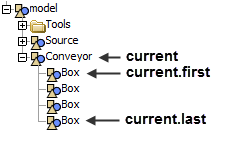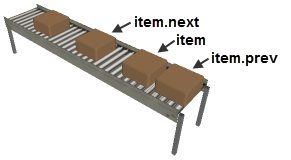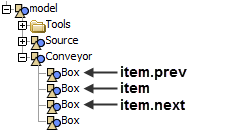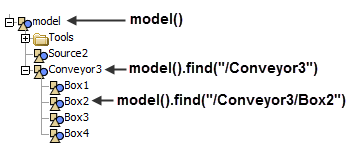treenode
Description
A class that represents a reference to a node in FlexSim's tree.
The treenode class is the base class for all objects and nodes accessed in FlexSim's tree. While you can access more data and functionality specific to nodes with object data by using the Object class, treenode is the most basic interface. First, it gives access to data and functionality associated with the tree structure itself. Second, it gives access to basic data stored on the nodes themselves, such as node names and data values. Third, since so much modeling logic uses labels, the treenode class provides a mechanism for easy manipulation of labels on objects, tokens, and task sequences.
The treenode class can be automatically down-cast to a subclass such as Object.
treenode src = model().find("Source1");
Object srcAsObject = src; // auto-down-cast to objectYou can also explicitly down-cast using the as() keyword
src.as(Object).location.x += 2;When FlexScript performs a down-cast, if the node is not a valid instance of the target class type, an invalid cast exception will be thrown.
Object src = model().find("Tools");// throws invalid cast exception
model().find("Tools").as(Object).location.x += 2; // throws invalid cast exceptionYou can check if a node is a given subclass type with the is() keyword.
if (model().find("Source1").is(Object)) {
...
}Null Values
In general, to check if a treenode is null just compare the treenode with NULL or put it directly in an if statement. Note that the keyword nullvar represents a null Variant and is not the same as a null treenode.
treenode fred = model().find("doesnotexist");
return fred == NULL; // true
return fred == nullvar; // false
return tonum(fred); // 0
if (fred) return 1; else return 0; // 0
if (objectexists(fred)) return 1; else return 0; // 0However, there are a few special cases:
1. A treenode returned by an old global command, such as node(). The return value could be the SAFEREF node, which is a valid memory address, but it doesn't exist in the main or view trees. To check for whether the treenode is a valid reference, you need to use objectexists(). For example:
treenode fred = node("doesnotexist", model());
return fred == NULL; // false
return fred == nullvar; // false
return tonum(fred); // a non-zero number
if (fred) return 1; else return 0; // 1
if (objectexists(fred)) return 1; else return 0; // 02. A treenode stored in a Variant, where the treenode pointer is pointing at 0x0, returned by a command that returns a Variant or by dynamic label access. In the the following example Processor1 has a label called myPointerLabel that has pointer data, but is not pointing at anything (or 0x0):
Object processor = model().find("Processor1");
Variant fred = processor.myPointerLabel;
return fred == NULL; // true
return fred == nullvar; // false
return tonum(fred); // 0
if (fred) return 1; else return 0; // 0
if (objectexists(fred)) return 1; else return 0; // 03. A Variant that is nullvar, where the type of the Variant was unknown. For example, reading the .value of a node where you don't know whether the node has no data or treenode data:
treenode Tools = model().find("Tools");
Variant fred = Tools.value;
return fred == NULL; // false
return fred == nullvar; // true
return tonum(fred); // 0
if (fred) return 1; else return 0; // 0
if (objectexists(fred)) return 1; else return 0; // 0For more information on checking what type of data a treenode holds or checking if it has data at all see the dataType property.
Properties
| dataType | Gets and sets the node's data type. |
| first | Gets the node's first subnode. |
| labelProperties | Use your own named properties to get/set label values. |
| labels | Accesses the node's labels as nodes. |
| last | Gets the node's last subnode. |
| name | Gets and sets the node's name. |
| next | Gets the next node after the node in the tree. |
| prev | Gets the node before the node in the tree. |
| rank | Gets/sets the rank of the node in its parent's sub-tree |
| subnodes | Accesses the node's subnodes |
| up | Gets and sets the node "above" the node in the tree, or in other words, its parent node. |
| value | Gets and sets the value on the node. |
Methods
| destroy | Destroys the node |
| evaluate | Evaluates the node. |
| find | Finds a node in the node's subtree by its path. |
| getPath | Gets the node's path, optionally relative to some other node. |
Details
treenode.dataType
int dataType
Description
Gets and sets the node's data type.
If you set dataType to a different value than the node's current data type, it will delete the node's current data and add the new data type. Usually you do not need to use this property since you can always just use treenode.value to get and set the value on a treenode.
The following are the values and macros available for dataType.
None = 0
DATATYPE_NUMBER = 1
DATATYPE_STRING = 2
DATATYPE_COUPLING = 3
DATATYPE_OBJECT = 4
DATATYPE_PARTICLE = 5
DATATYPE_BUNDLE = 6
DATATYPE_SIMPLE = 7
The following example assigns string data to current's label named "MyLabel" and returns that data type.
current.labels["MyLabel"].dataType = DATATYPE_STRING;
return current.labels["MyLabel"].dataType;You can check if a node has data by comparing the datatype to NULL.
node.dataType == NULLtreenode.first
readonly treenode first
Description
Gets the node's first subnode.
Returns a reference to the first subnode contained in the node. This is a shortcut for using node.subnodes[1], except that if it doesn't exist, node.first will simply return NULL, whereas node.subnodes[1] will throw an array out of bounds exception.


The following example sets the name of the first subnode of current to "FirstObj".
current.first.name = "FirstObj";treenode.labelProperties
Variant labelProperties
Description
Use your own named properties to get/set label values.
The treenode class allows you to get and set custom named properties that will apply to labels on an object. For example, if you want to set a label named "MyLabel" on current to a value of 5, you can write the following code:
current.MyLabel = 5;This will set the label's value to 5. If a label of that name does not exist, then it will be added to the object's labels.
If you want to return the value stored in current's "MyLabel" label, you can execute the following code:
return current.MyLabel;This label access mechanism is only available on nodes with object data, or on Process Flow tokens or task sequences. If you use this mechanism on a node that is not one of these types of node, FlexSim will throw an exception.
Using dynamic label property access gives you shorter syntax for what you could otherwise do with a bit longer expression.
| Short Syntax | Longer Equivalent Syntax |
|---|---|
current.MyLabel | current.labels["MyLabel"].evaluate() |
current.MyLabel = 5 | current.labels.assert("MyLabel").value = 5 * |
* Note that if you use the shorter syntax to set the code of a flexscript-toggled label, it will also automatically build the code's flexscript.
? Operator
There are, however, some caveats associated with this. Since FlexScript allows you to get/set any label names on a node, this does introduce a potential problem if you don't spell your labels correctly. For this reason, if you get a label that does not exist, FlexScript will throw an exception, pointing you immediately to the problem. If you intentionally want to access a label that may not exist (just return a null Variant, or nullvar, if it doesn't), then you can put a ? after the label name to signify that you don't want to throw an exception on an undefined label
The following code will simply return nullvar if the "MyLabel" label does not exist, instead of throwing an exception.
return current.MyLabel?;# Operator
Because your object already has its own properties there are certain label names that won't work as a dynamic property. For example:
current.next = 5;This will throw an exceptions since next is already a property on the treenode class and it is read-only. However, this doesn't mean it's impossible to have an object with a "next" label (for example you could add it to an object through the object's properties window). However, you can't access this label through dynamic properties in the same way as other labels without a name collision. In order to reference this label (or add it in the first place) with dynamic properties you need to add a # character before the label name:
current.#next = 5;This will correctly find the object's "next" label and not use its next property.
It is also possible that, as the software is updated, new properties will be added to objects that collide with label names used by your object in your model. In this case, your code will be automatically updated to use the # character so your code continues to work the same way. For example, say you are using a "position" label on one of your objects:
current.position = 5;Now, in the next update that object is updated and a new position property is added. Your code will be automatically updated to look like the following code snippet and will continue to work as before.
current.#position = 5;treenode.labels
readonly labels
Description
Accesses the node's labels as nodes.
This property allows you to access the node containing a label value. Usually you will not need to use this property, as you can use labelProperties. The exceptions to this rule are:
1. Your label names have spaces in them. - If your label names contain spaces, you will need to access them using the labels property:
current.labels["My Label Name"].value = 5;Since this code is more tedious than using labelProperties, we suggest not naming your labels with spaces.
2. You specifically want to access label nodes - In some cases you actually want to access label nodes, such as
when the label is a table of values. In this
case, you would use the labels property.Table myTable = current.labels["myTable"];
3. You want to assert the label if it doesn't exist. - Just like subnodes property, you can assert that a label exists. Optionally, you can pass in a default value to give the label if it does not exist:
// Set myValue to the value of MyLabel
// If MyLabel doesn't exist, create it
Variant myValue = current.labels.assert("MyLabel").value;// Increment the value of MyLabel by 10
// If MyLabel doesn't exist, create it and set its value to 1
current.labels.assert("MyLabel", 1).value += 10;treenode.last
readonly treenode last
Description
Gets the node's last subnode.
Returns a reference to the last subnode contained in the node. This is a shortcut for using node.subnodes[node.subnodes.length], except that if it doesn't exist, node.last will simply return NULL, whereas node.subnodes[node.subnodes.length] will throw an array out of bounds exception.


The following example sets the name of the last subnode of current to "FirstObj".
current.last.name = "FirstObj";treenode.next
readonly treenode next
Description
Gets the next node after the node in the tree.
Gets the node in the FlexSim tree that is in the same level and immediately after this node. If this node is the last node in the tree at that level, then this command returns NULL which means that the requested node does not exist.


The following example sets a label called "tally" to 0 on every item in the current. The variable item is used to store the reference to the item that is currently being worked on.
treenode item = current.first;
while (item) {
item.tally = 0;
item = item.next;
}treenode.prev
readonly treenode prev
Description
Gets the node before the node in the tree.
Gets the node in the FlexSim tree that is in the same level and immediately before this node. If this node is the first node in the tree at that level, then this command returns NULL which means that the requested node does not exist.


The following example sets a label called "tally" to 0 on every item in the current by traversing backwards through its subnodes. The variable item is used to store the reference to the item that is currently being worked on.
treenode item = current.last;
while (item) {
item.tally = 0;
item = item.prev;
}treenode.rank
int rank
Description
Gets/sets the rank of the node in its parent's sub-tree
The rank is the position in the tree layer that this node is in. The first node in a layer is rank 1, the second is rank 2, and so forth.
The following example sends a delayed message if item is the last subnode contained in current.
if (item.rank == current.subnodes.length)
senddelayedmessage(current,10,current,1,2,tonum(item));treenode.subnodes
readonly subnodes
Description
Accesses the node's subnodes
Accessing the Number of Subnodes
You can access the number of subnodes on current with the following code.
current.subnodes.lengthAccessing Subnodes by Rank
You can access an individual subnode by rank with the following code.
current.subnodes[1] // first subnode
current.subnodes[current.subnodes.length] // last subnode
current.subnodes[i] // i-th subnodeAccessing Subnodes by Name
You can access an individual subnode by name with the following code.
current.subnodes["Box1"] // subnode named "Box1"Asserting Subnodes by Name
You can assert a subnode by name with the following code.
// assert a label named "My Label"
current.attrs.labels.subnodes.assert("My Label") This will see if a node of that name already exists, and if it doesn't, it will add a subnode with that name. It returns the resulting subnode.
Asserting Subnodes with a Default Value
You can also assert a subnode by name and include a default start value with the following code.
// assert a label named "My Label" with a default value of 5
current.attrs.labels.subnodes.assert("My Label", 5) This is the same as the previous assert() call, except that if it needs to add the label, it will give the added label a value of 5.
Adding Subnodes
You can add a subnode with the following code.
// add a new node under current
current.subnodes.add()This will add a blank subnode under current. It returns the resulting subnode.
Clearing Subnodes
You can delete current's subnodes with the following code.
current.subnodes.clear(); Getting an Array of subnodes
You can create an Array of all the subnodes with the following code.
Array subnodes = current.subnodes.toArray(); treenode.up
treenode up
Description
Gets and sets the node "above" the node in the tree, or in other words, its parent node.
treenode box = Model.find("Source1/Box");
box.up; // gives Source1
box.up.up; // gives the modelSetting the up property causes the node to be transfered into the target node.
treenode box = Model.find("Queue1/Box");
box.up = Model.find("Queue2");treenode.value
Variant value
Description
Gets and sets the value on the node.
When getting a node's value, a node with number data will return a number, a node with text data will return text, and a node with coupling pointer data will return the target node pointed to. Nodes that hold array data will return the associated Array. Nodes that have object data return themselves since they store attribute nodes on themselves. Nodes without data will return a null Variant, or nullvar. Additionally, some nodes may hold "custom" data, using a customization class called SimpleDataType, or SDT. For these types, the customization class can define what is returned when value is accessed or set. For example, for a node that contains tracked variable data, such as current.attrs.state_current or current.attrs.stats_content, the value property will return the tracked variable's current value (same as getstat(current.attrs.state_current, "", STAT_CURRENT), etc.), and setting the value will update the tracked variable's current value.
Examples
Get the shape path associated with current's 3D shape file:
string shapePath = current.attrs.shape.value;Get current's shape index
int shapeIndex = current.attrs.shapeindex.value;Set the value of current's "My Label" label to 5. (Note that you can do this easier using labelProperties if you don't put spaces in your label names).
current.labels["My Label"].value = 5;Assert and set the value of current's "Loading Operator" label to point to Operator1 in the model.
current.labels.assert("Loading Operator").value = Model.find("Operator1");Assert and set the value of current's "Loading Operators" label to an array pointing to 3 operators in the model.
current.labels.assert("Loading Operators").value =
[Model.find("Operator1"), Model.find("Operator2"), Model.find("Operator3")];Assert a subnode named "OperatorName" into the model tools folder and give it the value "Operator1"
Model.find("Tools").subnodes.assert("OperatorName").value = "Operator1";treenode.destroy()
| void destroy( ) |
Description
Destroys the node
Once you call this method on a node, it will have been destroyed and you should not reference the node anymore.
The following example destroyes all but one subnode of current.
while (current.subnodes.length > 1)
current.last.destroy();treenode.evaluate()
| Variant evaluate( ) |
| Variant evaluate( Variant p1 ... p20 ) |
Parameters
| p1-p20 | Parameters to be passed into the evaluation. These parameters can be accessed from within the node's code using param(1), param(2), etc. |
Returns
| Variant | The result of the execution of the node's code, if it is code-toggled. Otherwise, it will return the node's value. |
Description
Evaluates the node.
Calling evaluate() will return the same value as treenode.value if the node has number, non-code text, or array data. If the node has text data and is toggled as code (either dll, c++, or FlexScript) then evaluate() will execute that code and return the resulting value.
treenode.find()
| treenode find( string path ) |
Parameters
| path | The path, starting at the node, that addresses the target node. |
Returns
| treenode | If the addressed node exists, the method returns that node, otherwise NULL. |
Description
Finds a node in the node's subtree by its path.
This method is generally used to access nodes in the tree for which there are no other specific commands available. This command uses a path syntax not unlike unix/windows file paths. There are several path symbols you can use to traverse the tree, as listed below:
/ This symbol tells the traversal to go into the current node's sub-tree.
> This symbol tells the traversal to go into an object's attribute tree.
.. This symbol tells the traversal to go to the current node's parent tree, or up one level.
~ This symbol may have two meanings depending on context. If the symbol is encountered directly after another
special symbol (such as >objectfocus+/~), then it tells the traversal to go to the owning object of the current node.
For example, if the current node is within the attributes tree of an object, ~ will go up to the object itself. If, however,
the symbol is encountered after a node name, it will expect a number after the symbol, defining the "nth" object
with the given name. For example, a path of MODEL:/Processor~5 will return the 5th object named Processor in the model.
@ This symbol tells the traversal to go to the owner view of the current node.
+ This symbol tells the traversal to read the current node's text as a path to an object (or if the node has
pointer data, it reads the value of the pointer), and go to that object.
" Put quotes around an object name if the name contains special path characters. For example, the path
MODEL:/"Is Distance > Max Distance?" will return the object named Is Distance > Max Distance? in
the model.
? This symbol tells the traversal to perform a recursive tree search for the subsequent name. For
example, model().find("/?FlowItemBin") will search for a node with the name FlowItemBin in the model tree.
This returns the same node reference as an explicit path definition would: model().find("/Tools/FlowItemBin")
$ Surround a macro or flexscript with $ characters to dynamically define ranking or node references. For example,
if you have defined a global macro MY_RANK as 8, then the path MODEL:/$MY_RANK$ will get the 8th ranked object in the model.
If you define flexscript here, use i to get the current node. For example, the path
MODEL:/Processor1/$outobject(i, 3)$ will return the object connected to the 3rd output port of the object named
Processor1 in the model.
For the most part, you will only use the / and > symbols, and occasionally the .. symbol. The @ and + symbols are usually only used when you are building a custom GUI.
There is also a feature that lets you specify a node by its rank instead of by its name. Just put a number in the place where an object's name usually goes, and the ranked node will be accessed instead.
You can also define one of several optional starting point keywords in the path, in place of startnode. This will override
the defined node (the node left of the dot) as the path starting point. They are:
MAIN:/ Starts at the main project tree
MODEL:/ Starts at the model tree
VIEW:/ Starts at the view tree
 Example 1:
Example 1:
treenode curnode = model().find("/Conveyor3/Textured Colored Box");
This sets the variable curnode to a reference to an object named "Textured Colored Box", which is found in the object called "Conveyor3", which is found in the model.
Example 2:
treenode curnode = model().find("/Conveyor3/3");
This example sets curnode to the 3rd ranked object in the object named "Conveyor3" in the model. This provides an advantage over the first example since often flowitems will all have the same name, so the path "/Conveyor3/Textured Colored Box" will only give you access to the first flowitem named "Textured Colored Box" in Conveyor3. If several flowitems are in Conveyor3 and all have the name "Textured Colored Box", then you can use the path "/Conveyor3/2" to get the 2nd ranked flowitem, the path "/Conveyor3/3" to get the 3rd ranked flowitem, and so forth.
Example 3:
treenode exittriggernode = model().find("/Conveyor3>variables/exittrigger");
This example sets exittriggernode to reference the exittrigger variable on Conveyor3 in the model. Note that this uses the > symbol to go into the Conveyor's object attributes tree instead of the Conveyor's sub-tree like the first example did. Note that the object attribute tree holds things like labels, variables, size, location, etc., whereas the object sub-tree holds other objects like flowitems.
Example 4:
treenode focus = c.find("@>objectfocus+");
This example would typically be used in a GUI. It gets access to the object that a parameters/properties window is "pointing to". For more information, refer to the topic on Graphical User Interfaces in the user manual.
treenode.getPath()
| string getPath( treenode relativeTo = 0 , int byName = 1 ) |
Parameters
| relativeTo | If defined, the resulting path will be relative to that node. If left out, the path will be a globally-defined path that includes a root node prefix, such as MODEL:/. |
| byName | If defined, 0 means the resulting path will be a sequence of numbered ranks in the tree. 1 means the resulting path will be a sequence of named nodes. |
Returns
| string | The node's path. |
Description
Gets the node's path, optionally relative to some other node.